Impact of Aggregate Grain Size on ASR-Induced Expansion
Abstract
:1. Introduction
2. Materials and Methods
3. Results and Discussion
3.1. ASR Expansion
3.2. Macroscopic and Microscopic Examination
4. Conclusions
- Post-glacial gravel aggregate exhibits moderate reactivity with alkalis, and the reaction, under the conditions specified in the ASTM C1260 standard method, i.e., storage in 1 M NaOH at T = 80 °C, occurs quickly.
- The particle size of the aggregate affects the expansion generated by it in mortars. Grains of all aggregate fractions containing reactive silica react with alkalis, resulting in the formation of ASR gel, visible on the surface of mortars as white efflorescence and identified in cracked grains, propagating into the cement paste.
- The most harmful for mortar durability turned out to be reactive aggregate grains of the 1–2 mm fraction. Fine aggregate with a particle size of 0.125–0.5 mm, when reacting with alkalis, did not cause expansion in the mortars made from them. Mortars with an aggregate particle size of 2–4 mm, despite evident signs of reaction visible in the form of efflorescence and surface pop outs, also showed low expansion. The reaction of larger aggregate grains is likely slower, as evidenced by the delayed expansion. Surface pop outs are likely the result of greater availability of alkaline solution to the reactive grain.
- The cumulative expansion of mortars made from individual fractions of the tested aggregate is approximately three times smaller than the expansion of mortars containing only gravel aggregate. It is presumed that the smaller cumulative expansion of mortars containing individual fractions of reactive aggregate results from the properties of the cement paste, as indicated by Durant and Scrivener, i.e., in mortars made with 100% gravel aggregate, all reactive grains induce stresses on the cement paste, leading to its cracking and, thus, larger expansions. In mortars with individual fractions of reactive aggregate, the microstructure of the cement paste is different, i.e., not weakened by many corrosion centers, and therefore exhibits different mechanical properties.
- X-ray micro-computed tomography (µCT) indicates that both fine and coarse particles undergo a harmful reaction with alkalis, leading to various degrees of deterioration. Differences were noted in the degree of particle reaction and cracking due to the occurring corrosion processes, which was also confirmed by scanning electron microscopy. Significant cracking of the cement matrix was also observed.
- The reaction products cover the reactive aggregate surfaces or fill the cracks within the aggregate particles. ASR gels generate various swelling pressures that cause varying degrees of particle deterioration. The gels also run through the cement paste, causing cracking and partially filling the cracks.
- ASR gel, partially filling the air voids in mortars made from reactive aggregate, generates pressure in the cement paste, leading to its cracking. Therefore, the amount of gel produced in mortars affects the increase in expansion. The studied reactive system is complex and requires further research, including determining the influence of the cement-to-reactive aggregate ratio and analyzing the rheological properties of gels.
- The indicated influence of the aggregate particle size on mortar damage caused by ASR is not synonymous with the necessity of analyzing individual aggregate fractions in assessing its susceptibility to ASR. It should be noted that in the case of mechanically crushed aggregates, the presence of cracks in the grains that facilitate the access of aggressive ions to reactive silica can be significant. The results obtained indicate that when considering the aggregate’s reactivity, 100% of its content should be taken into account.
Funding
Institutional Review Board Statement
Informed Consent Statement
Data Availability Statement
Conflicts of Interest
References
- PN-EN 12620+A1; Aggregates for Concsrete. Polish Committee for Standardization: Warsaw, Poland, 2010.
- Stanton, T.R. Expansion of concrete through reaction between cement and aggregate. Proc. Am. Soc. Civ. Eng. 1940, 66, 1781–1811. [Google Scholar] [CrossRef]
- Shehata, M.H.; Thomas, M.D.A. The effect of fly ash composition on the expansion of concrete due to alkali-silica reaction. Cem. Concr. Res. 2000, 30, 1063–1072. [Google Scholar] [CrossRef]
- McCoy, W.J.; Caldwell, A.G. New approach in inhibiting alkali-aggregate expansion. ACI Mater. J. 1951, 22, 693–706. [Google Scholar]
- Afshinnia, K.; Rangaraju, P.R. Efficiency of ternary blends containing fine glass powder in mitigating alkali–silica reaction. Constr. Build. Mater. 2015, 100, 234–245. [Google Scholar] [CrossRef]
- Zapała-Sławeta, J. Combined Influence of Lithium Nitrate and Metakaolin on the Reaction of Aggregate with Alkalis. Materials 2023, 16, 382. [Google Scholar] [CrossRef]
- Owsiak, Z.; Czapik, P.; Zapała-Sławeta, J. Methods of mitigating alkali reactivity of gravel aggregate. Struct. Environ. 2022, 14, 102–109. [Google Scholar] [CrossRef]
- Lindgård, J.; Nixon, P.J.; Borchers, I.; Schouenborg, B.; Wigum, B.J.; Haugen, M.; Åkesson, U. The EU “PARTNER” Project—European standard tests to prevent alkali reactions in aggregates: Final results and recommendations. Cem. Concr. Res. 2010, 40, 611–635. [Google Scholar] [CrossRef]
- Poole, A.B. Introduction to alkali–aggregate reaction in concrete. In The Alkali Silica Reaction in Concrete; Swamy, R.N., Ed.; Van Nostrand Reinhold: New York, NY, USA, 1992. [Google Scholar]
- Broekmans, M.A.T.M. Structural properties of quartz and their potential role for ASR. Mater. Charact. 2004, 53, 129–140. [Google Scholar] [CrossRef]
- Ichikawa, T. Alkali–silica reaction, pessimum effects and pozzolanic effect. Cem. Concr. Res. 2009, 39, 716–726. [Google Scholar] [CrossRef]
- Hoobs, D.V. Alkali-Silica Reaction in Concrete; Thomas Telford: London, UK, 1988. [Google Scholar]
- Hobbs, D.W. History, the Reaction, Cracking and Pessimum Behaviour in Alkali-Silica Reaction in Concrete; Chapter 3; Thomas Telford: London, UK, 1988; pp. 1–33. [Google Scholar]
- Shayan, A. The pessimum effect in an accelerated mortar bar test using 1M NaOH solution at 80 °C. Cem. Concr. Compos. 1992, 14, 249–255. [Google Scholar] [CrossRef]
- Diamond, S.; Thaulow, N. A study of expansion due to alkali –silica reaction as conditioned by the grain size of the reactive aggregate. Cem. Concr. Res. 1974, 4, 591–607. [Google Scholar] [CrossRef]
- Zhang, C.; Wang, A.; Tang, M.; Wu, B.; Zhang, N. Influence of aggregate size and aggregate size grading on ASR expansion. Cem. Concr. Res. 1999, 29, 1393–1396. [Google Scholar] [CrossRef]
- Dunant, C.F.; Scrivener, K.L. Effects of aggregate size on alkali-silica-reaction induced expansion. Cem. Concr. Res. 2012, 42, 745–751. [Google Scholar] [CrossRef]
- Lu, D.; Fournier, B.; Grattan-Bellew, P.; Lu, Y.; Xu, Z.; Tang, M. Expansion behavior of Spratt and Pittsburg limestones in different test procedures. In Proceedings of the 13th International Conference on Alkali–Aggregate Reactions in Concrete, Trondheim, Norway, 16–20 June 2008; Broekmans, M.A.T.M., Wigum, B.J., Eds.; pp. 619–627. [Google Scholar]
- Vivian, H.E. Studies in cement aggregate reaction. Bulletin 1950, 256, 13–20. [Google Scholar]
- Poyet, S.; Sellier, A.; Capra, B.; Foray, G.; Torrenti, J.M.; Cognon, H.; Bourdarot, E. Chemical modelling of alkali silica reaction: Influence of the reactive aggregate size distribution. Mater. Struct. 2007, 40, 229–239. [Google Scholar] [CrossRef]
- Cyr, M.; Rivard, P.; Labrecque, F. Reduction of ASR-expansion using powders ground from various sources of reactive aggregates. Cem. Concr. Compos. 2009, 31, 436–446. [Google Scholar] [CrossRef]
- Multon, S.; Leklou, N.; Petit, L. Coupled effects of aggregate size and alkali content on ASR expansion. Cem. Concr. Res. 2008, 38, 350–359. [Google Scholar] [CrossRef]
- Nishibayashi, S.; Yamura, K. Effect of reactive fine aggregate on expansion characteristics of concrete due to alkali aggregate reaction. In Proceedings of the 9th International Conference on Alkali-Aggregate Reaction in Concrete, London, UK, 27–31 July 1992; pp. 723–730. [Google Scholar]
- Wigum, B.; Lindgĺrd, J. AAR: Testing, mitigation & recommendations. The Norwegian approach during two decades of research. In Proceedings of the 13th ICAAR—International Conference on Alkali–Aggregate Reactions, Trondheim, Norway, 16–20 June 2008; pp. 1299–1309. [Google Scholar]
- Dahl, P.A.; Lindgård, J.; Danielsen, S.W.; Hagby, C.; Kompen, R.; Pedersen, B.; Rønning, T.F. Specifications and guidelines for production or AAR resistant concrete Norway. In Proceedings of the 12th ICAAR Conference, Beijing, China, 15–19 October 2004; pp. 499–504. [Google Scholar]
- Norwegian Concrete Association. Alkali–Aggregate Reactions in Concrete, Test Methods and Requirements to Test Laboratories; NB32; NB Publ.: Oslo, Norway, 2005. (In Norwegian) [Google Scholar]
- Norwegian Concrete Association: Durable Concrete Containing Alkali Reactive Aggregates, NB21. 2004, p. 33. Available online: https://icaarconcrete.org/wp-content/uploads/2020/11/15ICAAR-LindgardJ-1.pdf (accessed on 2 December 2023).
- Langer, W.H.; U.S. Natural Aggregates of the Conterminous United States. Geological Survey Bulletin 1594; United States Government Printing Office: Washington, DC, USA, 1988.
- Kozioł, W.; Ciepliński, A.; Machniak, Ł.; Borcz, A. Aggregates in construction. Nat. Aggreg. 2015, 1, 98–100. [Google Scholar]
- Brandt, A.M. Cement-Based Composites, Materials, Mechanical Properties and Performance, 2nd ed.; CRC Press: Boca Raton, FL, USA, 2009; p. 94. [Google Scholar]
- Naziemiec, Z.; Pabiś-Mazgaj, E. Preliminary evaluation of the alkali reactivity of crushed aggregates from glacial deposits in northern Poland. Road Briges 2017, 16, 203–222. [Google Scholar] [CrossRef]
- Zapała-Sławeta, J.; Owsiak, Z. Selected methods of preventing the effects of gravel aggregate reactivity. Inżynieria I Bud. 2020, 76, 542–546. [Google Scholar]
- ASTM C1293-20a; Standard Test Method for Determination of Length Change of Concrete Due to Alkali-Silica Reaction. ASTM International: West Conshohocken, PA, USA, 2008.
- Czapik, P. Degradation of Glaukonite Sandstone as a Result of Alkali-Silica Reactions in Cement Mortar. Materials 2018, 11, 924. [Google Scholar] [CrossRef] [PubMed]
- ASTM C1260; Standard Test Method for Potential Alkali Reactivity of Aggregates (Mortar-Bar Method). ASTM: West Conshohocken, PA, USA, 2007; p. 5.
- Ramyar, K.; Topal, A.; Andiç, Ö. Effects of aggregate size and angularity on alkali–silica reaction. Cem. Concr. Res. 2005, 35, 2165–2169. [Google Scholar] [CrossRef]
- Reinhardt, H.W.; Mielich, O. A fracture mechanics approach to the crack formation in alkali-sensitive grains. Cem. Concr. Res. 2011, 41, 255–262. [Google Scholar] [CrossRef]
- Owsiak, Z.; Zapała-Sławeta, J.; Czapik, P. Sources of the Gravel Aggregate Reaction with Alkalis in Concrete. Cem. Lime Concr. 2012, 3, 149–153. [Google Scholar]
- Werner, D.; Meng, B.; Weise, F. Influence of aggregate size on the damage potential of alkali-silica reaction. In Proceedings of the 15th International Conference of Alkali Aggregate Reaction in Concrete (ICAAR 2016), Sao Paulo, Brasil, 3–7 July 2016. [Google Scholar]
- Kamalian, S.; Lev, M.H.; Gupta, R. Computed Tomography Imaging and Angiography—Principles; Elsevier B.V.: Amsterdam, The Netherlands, 2016. [Google Scholar]
- Ichikawa, T.; Miura, M. Modified model of alkali-silica reaction. Cem. Concr. Res. 2007, 37, 1291–1297. [Google Scholar] [CrossRef]
- Dunant, C.; Scrivener, K.L. Micro-mechanical modeling of alkali-silica-reaction induced degradation using the AMIE framework. Cem. Concr. Res. 2010, 40, 517–525. [Google Scholar] [CrossRef]
- Vayghan, A.G. Characterization of the Rheological and Swelling Properties of Synthetic Alkali Silicate Gels in Order to Predict Their Behavior in ASR Damaged Concrete. Doctoral Dissertation, The Pennsylvania State University, State College, PA, USA, 2017. [Google Scholar]
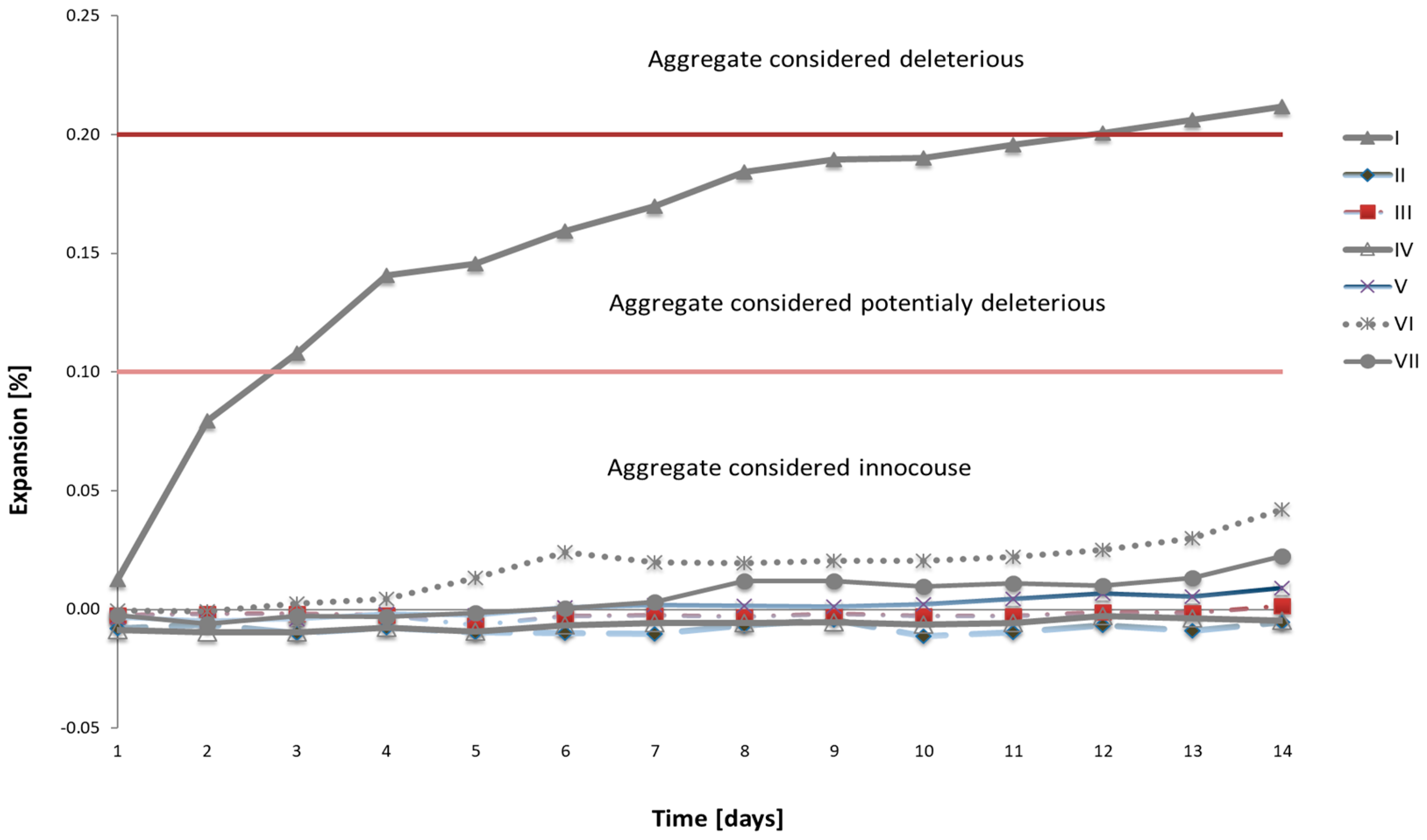
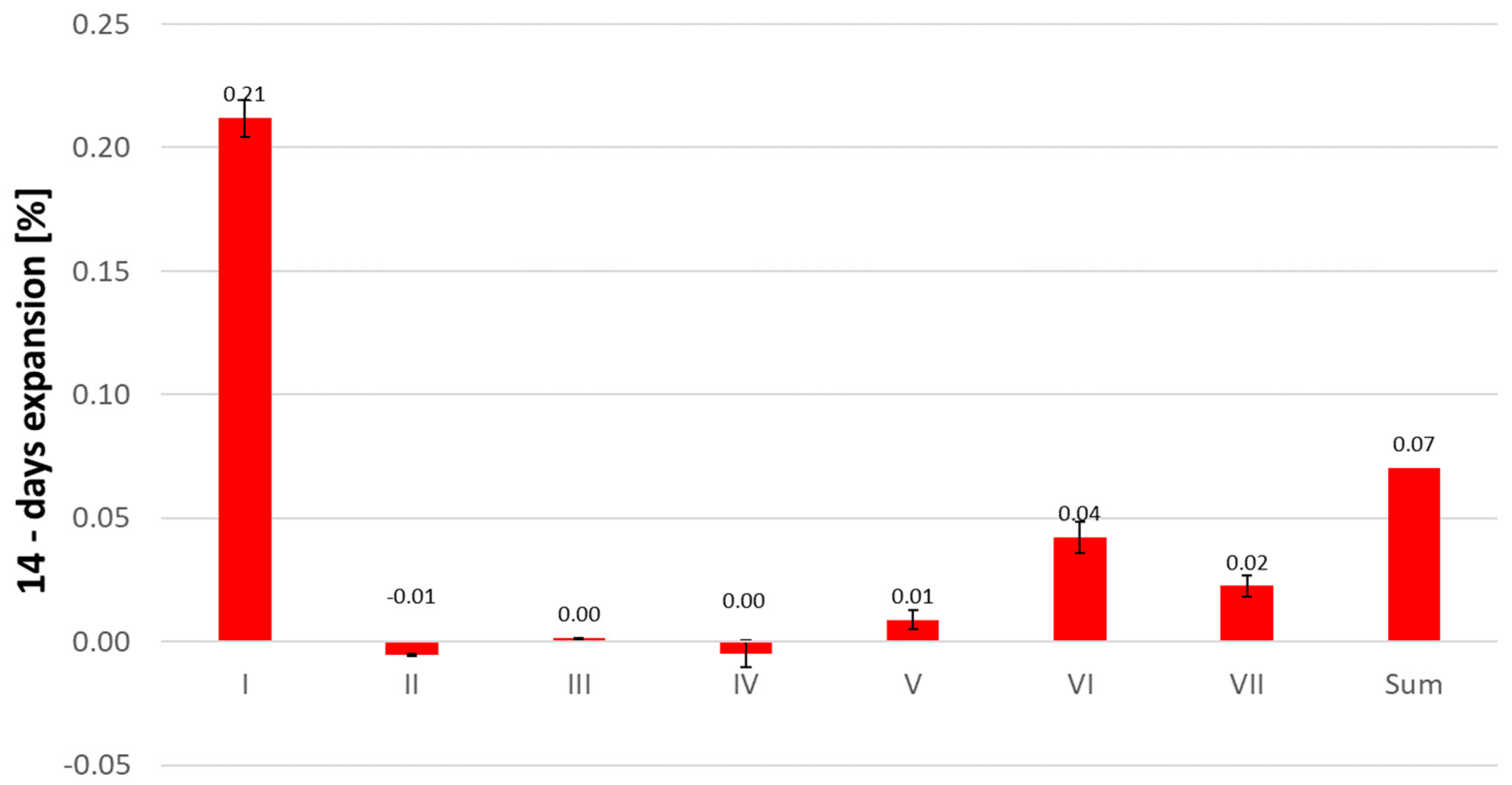
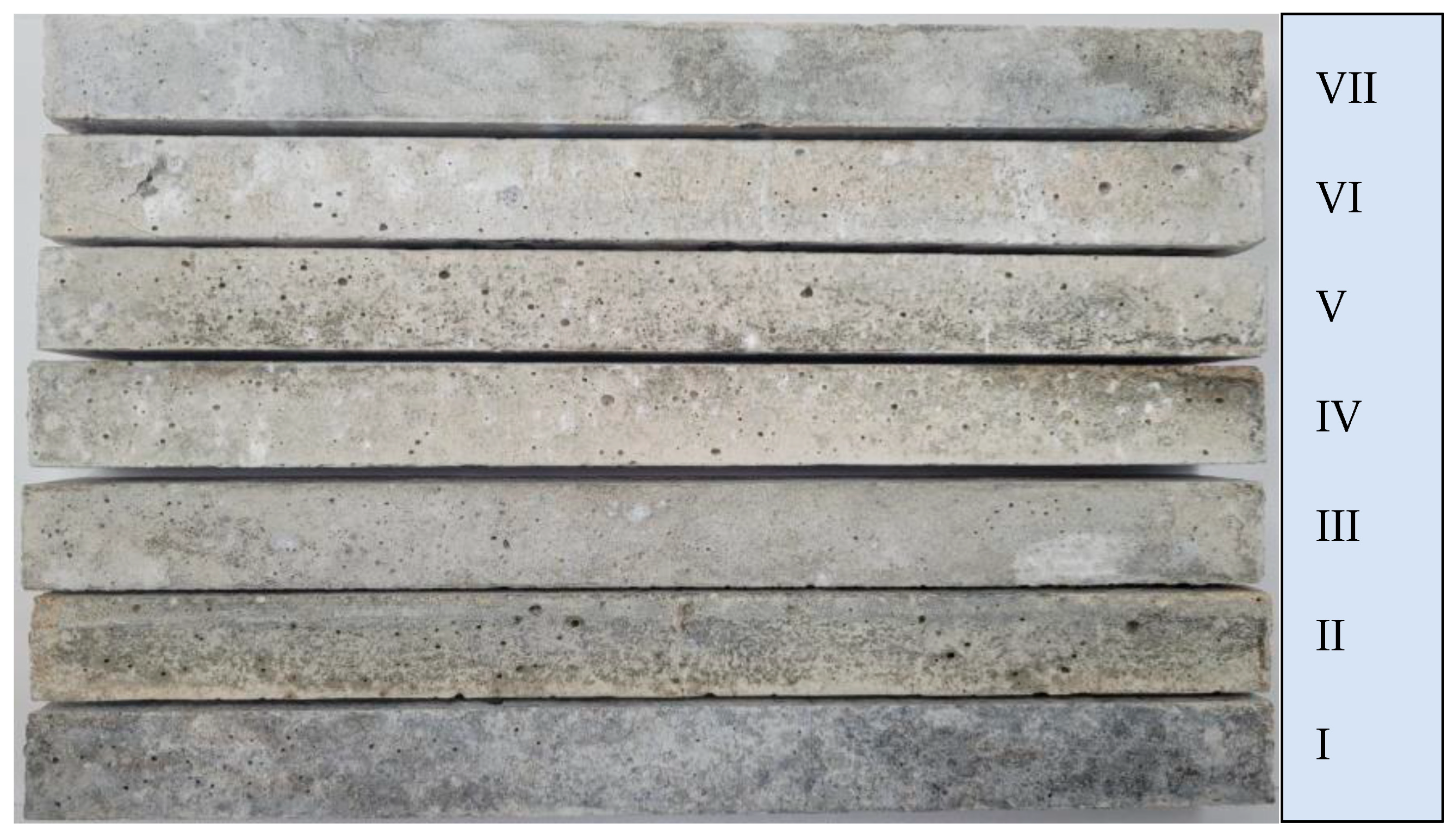
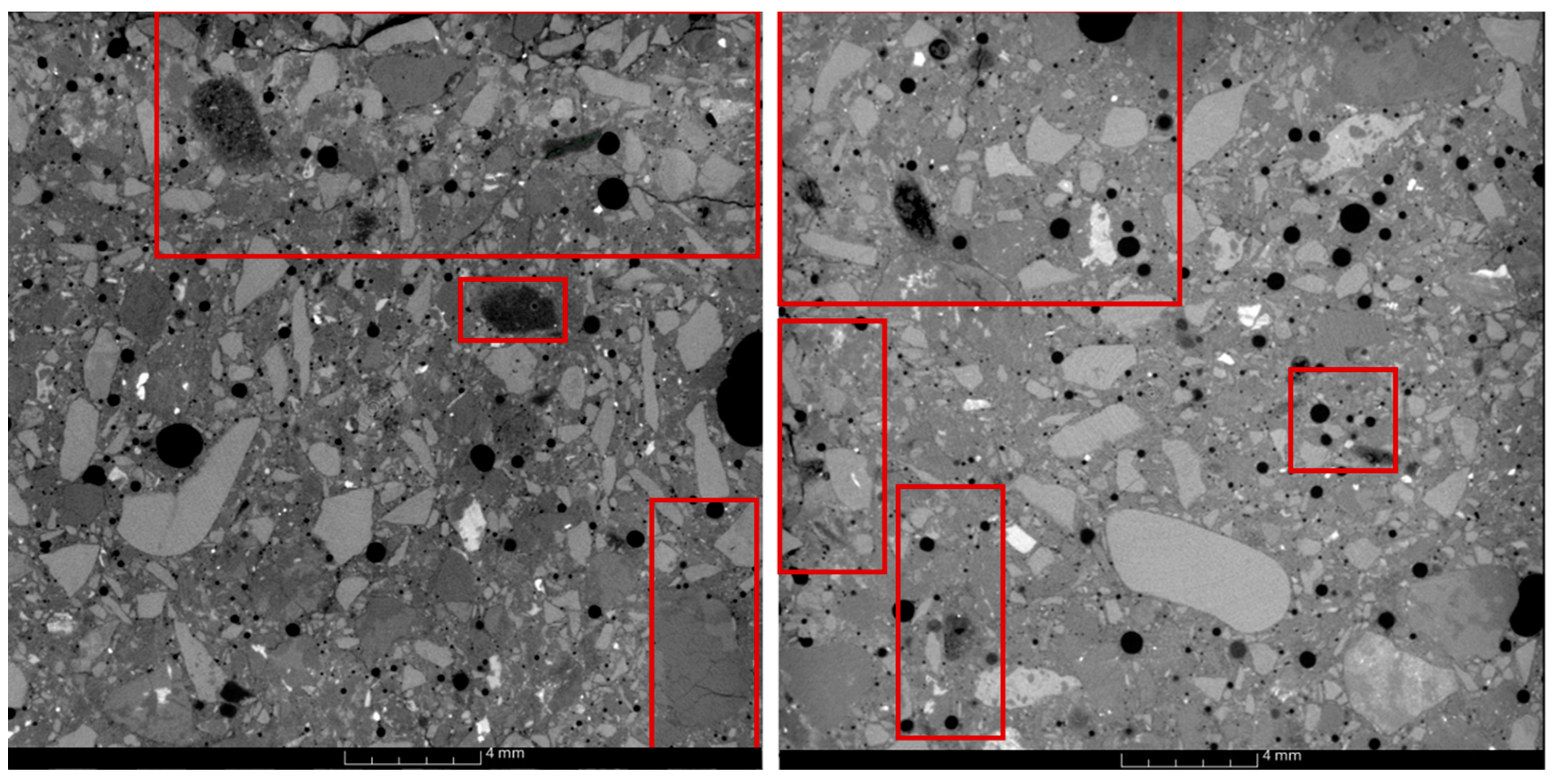
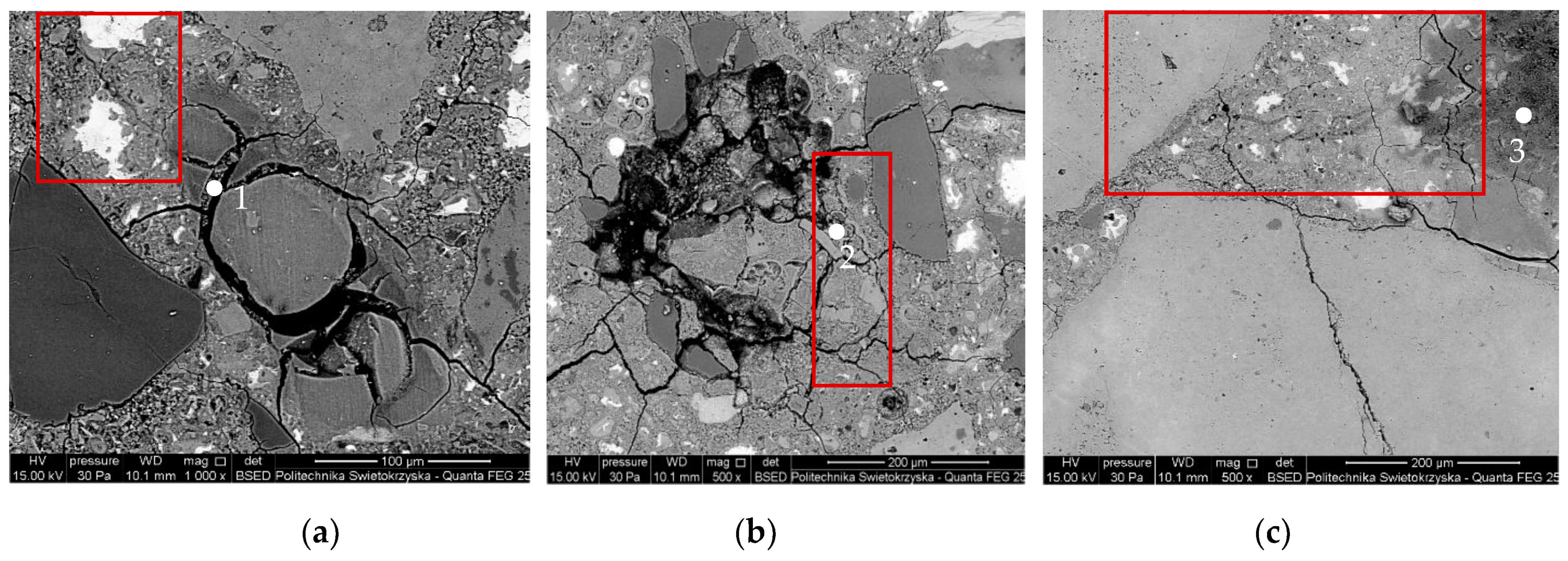
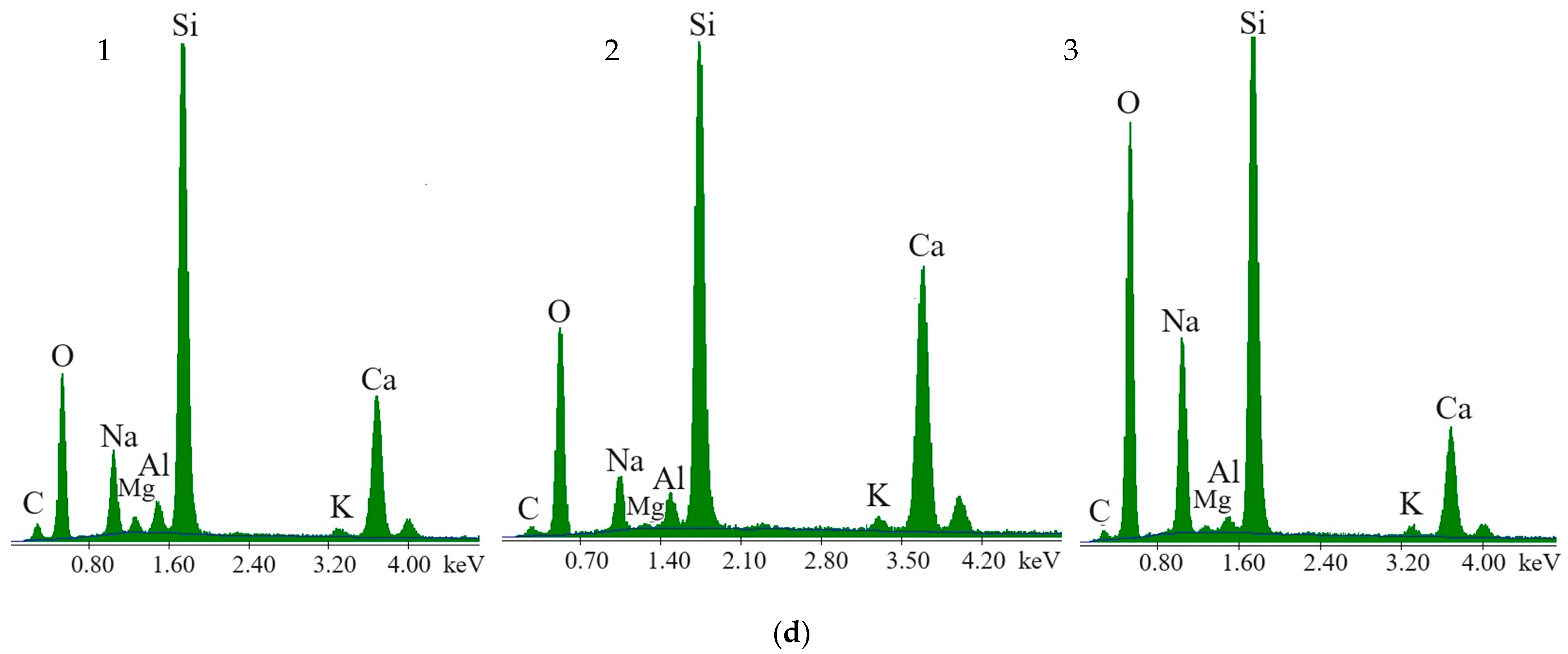
| Rock | Quartz–Glauconite Sandstone | Organodetritic Sparitic–Micritic Limestone | Metamorphic Quartz–Pyroxene Shale | Feldspar–Biotite Granite | Non-Reactive Components |
|---|---|---|---|---|---|
| Content | 13.8 | 28.0 | 3.9 | 10.5 | 43.8 |
| Material | SiO2 | Al2O3 | Fe2O3 | CaO | MgO | SO3 | K2O | Na2O | Na2Oe |
|---|---|---|---|---|---|---|---|---|---|
| Cement | 19.60 | 4.60 | 3.15 | 62.35 | 2.19 | 3.11 | 1.02 | 0.18 | 0.85 |
| Fraction Size (mm) | Fraction Content (%) | Sample Marking | ||||||
|---|---|---|---|---|---|---|---|---|
| I | II | III | IV | V | VI | VII | ||
| Pure | Substitution Mixtures | |||||||
| 0.125–0.25 | 10 | R | L | R | L | L | L | L |
| 0.25–0.5 | 25 | R | L | L | R | L | L | L |
| 0.5–1 | 25 | R | L | L | L | R | L | L |
| 1–2 | 25 | R | L | L | L | L | R | L |
| 2–4 | 15 | R | L | L | L | L | L | R |
Disclaimer/Publisher’s Note: The statements, opinions and data contained in all publications are solely those of the individual author(s) and contributor(s) and not of MDPI and/or the editor(s). MDPI and/or the editor(s) disclaim responsibility for any injury to people or property resulting from any ideas, methods, instructions or products referred to in the content. |
© 2023 by the author. Licensee MDPI, Basel, Switzerland. This article is an open access article distributed under the terms and conditions of the Creative Commons Attribution (CC BY) license (https://creativecommons.org/licenses/by/4.0/).
Share and Cite
Zapała-Sławeta, J. Impact of Aggregate Grain Size on ASR-Induced Expansion. Materials 2023, 16, 7506. https://doi.org/10.3390/ma16247506
Zapała-Sławeta J. Impact of Aggregate Grain Size on ASR-Induced Expansion. Materials. 2023; 16(24):7506. https://doi.org/10.3390/ma16247506
Chicago/Turabian StyleZapała-Sławeta, Justyna. 2023. "Impact of Aggregate Grain Size on ASR-Induced Expansion" Materials 16, no. 24: 7506. https://doi.org/10.3390/ma16247506
APA StyleZapała-Sławeta, J. (2023). Impact of Aggregate Grain Size on ASR-Induced Expansion. Materials, 16(24), 7506. https://doi.org/10.3390/ma16247506






